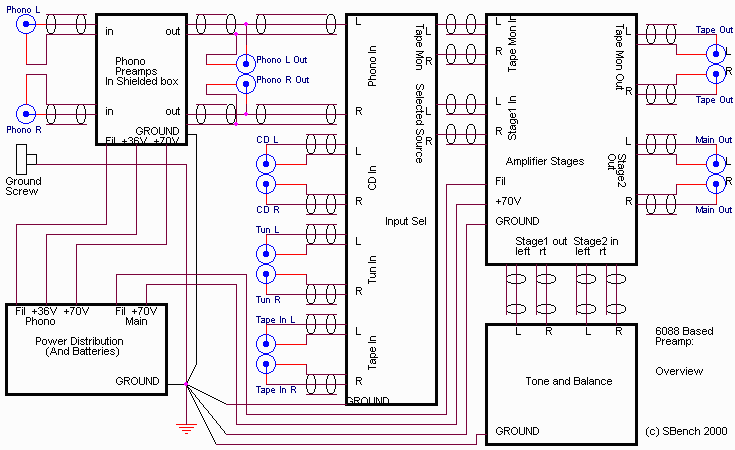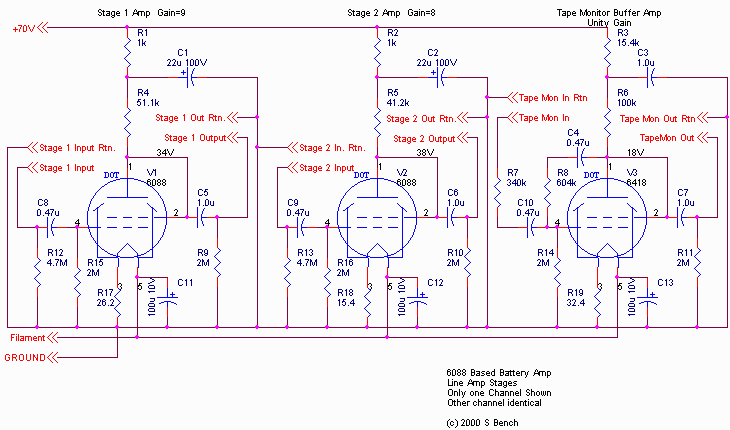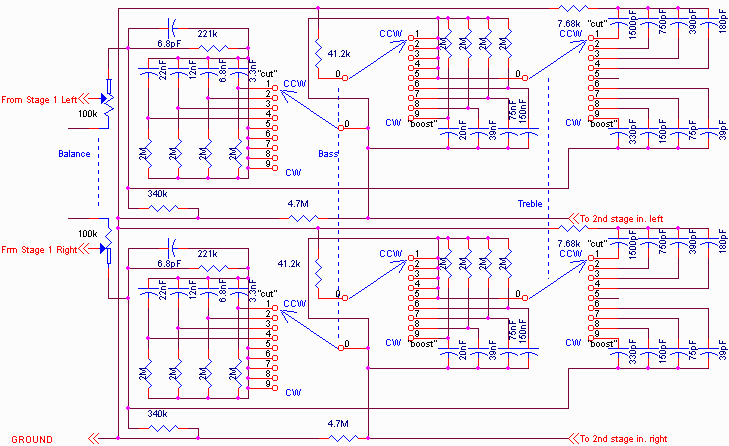
In this final part of the series, we will cover the main amplifying stages, tone and balance operation and some miscellaneous notes about this amplifier.
Main Amplifying stages
The main amplifying stages are triode connected 6088 stages. As indicated from the previous part, there are two amplifying stages. This provides a non-inverted input to output connection, as well as sufficient gain to incorporate tone control. The tone controls are switch selected so that "flat" bypasses all reactive elements; truely flat response. The overall circuit topology is again shown here for completeness:

In the schematics shown, only one channel is shown. These are duplicated for stereo. The amplifier stages are:

Notice that the first stage is slightly starved. This provides a gain of about 9. This drives the tone control and balance circuits that introduce a loss of about 7.2. The second stage is operated at slightly higher current, and has a lower plate resistor, so that the preamp "output" impedance is less than 10k. The second stage has a gain of about 8, so the overall "line" stage has a gain of about 10 (20dB). It will produce about 10VRMS without much distortion.
The amplifier section is mounted on a separate board containing all 6 "line" side amplifying tubes. For consistency in any projected modifications to the circuit, I provided a DC ground path and isolated all inputs and outputs. That's the extra r's and c's on the input and output sides of the amplifiers. You don't always NEED to do this, but it does provide a guaranteed DC return no matter what you connect to it. (The exception is the input to the tape monitor, since the rest of the circuit guarantees the idling potential at this point.)
The "tape monitor" output is isolated. The uses a 6418 (an even smaller device) as a unity gain inverting buffer which has a low output impedance by virtue of the "feedback" localized to that stage. Interestingly, by comparing the sound of the phono run directly from the direct phono output to the phono output run from the tape monitor, you can get a good idea of what that stage does to the sound quality. (Some like it, some don't).
Tone and Balance Controls
The only additional electronics are the tone and balance circuits, shown here:

The balance provides a subtle action: only 4dB change for the control range. This is done for several reasons:
The 6.8pF "gimmick" capacitor compensates for the capacitance of the wiring and input capacitance of the final stage. This allows the overall frequency response to extend to about 100kHz.
The tone controls are subtle in their action. Since the reactance (capacitor) is switched, the "corner" frequency changes as the control is moved. This provides a better sounding control (in my opinion) than fixed capacitor and variable resistance, which tends to shift the maximum available boost/cut as well as the corner frequency. Also tends to minimize midrange interaction of the bass and treble controls as well. The high value resistors in the bass cut section control the maximum "cut" providing a shelf rather than continuing rolloff and also minimize "popping" as the switch is changed. The resistors in the bass boost section also minimize popping. In principle, this could be done for the treble controls as well. Usually, the smaller capacitor values associated with the treble section have a more benign "pop" anyway.
Miscellaneous notes:
The sound of this preamp is not too bad overall. The batch of 6088s I used seem plagued by a high frequency microphonic noticeable in the line stage as well as the phono section. When I auditioned this preamp to a number of audiophiles, you could hear it if you "banged" on the preamp, but was not apparent in normal listening.
The inductor used in the "loudness" control introduces a little hum if the preamp is nearby any transformers or AC sources. For best results, this should be a "shielded" inductor. (which is NOT what I happened to use).
Battery life appears to be consistent with the calculations I previously made. Reasonable lifetime can be expected. Since there are two LED monitors, it is easy to tell when the batteries need changed.
-Steve